Effect of Redox Switch, Coupling, and Continuous Polarization on the Anti-Corrosion Properties of PEDOT Film in NaCl Solution
Abstract
1. Introduction
2. Materials and Methods
2.1. Material and Substrate Preparation
2.2. Electrochemical Measurements
2.3. Surface Characterization
3. Results
3.1. Electrodeposition of PEDOT on SS
3.2. Cyclic Voltammetry
3.3. Open-Circuit Potential
3.4. Galvanic Coupling
3.5. EIS
3.6. Raman Spectroscopy
3.7. Surface Characterization
3.8. XPS
4. Discussion
4.1. Corrosion Protection Mechanism
- Anodic reactions:
- Cathodic reactions:
4.2. Polarization Behavior
5. Conclusions
- (1)
- The PEDOT film exhibited barrier protection and mediated the oxygen reduction reaction on SS.
- (2)
- The PEDOT film was initially reduced by coupling with the SS substrate and then re-oxidized by dissolved O2.
- (3)
- The scratched PEDOT film prevented surface charge localization, resulting in the electrochemical protection of SS.
- (4)
- With polarization at cathodic potentials from –0.4 V to –0.7 V, PEDOT was dedoped, which caused the polymer structure to shrink, thereby preventing nucleophile attacks.
- (5)
- The electroactivity and conductivity of the polymer film declined when PEDOT was polarized at potentials >–0.7 V.
- (6)
- OH− ions generated from the oxygen reduction reaction attacked the polymer chain, causing the formation of carbonyl and sulfone groups, evidenced by XPS results of the degraded film. Degradation (over-oxidation) of the PEDOT coating due to attacks by OH− ions was favored by prolonged exposure to oxygen.
Author Contributions
Funding
Institutional Review Board Statement
Informed Consent Statement
Data Availability Statement
Acknowledgments
Conflicts of Interest
References
- Namsheer, K.; Rout, C.S. Conducting polymers: A comprehensive review on recent advances in synthesis, properties and applications. RSC Adv. 2021, 11, 5659–5697. [Google Scholar]
- Tallman, D.E.; Pae, Y.; Bierwagen, G.P. Conducting polymers and corrosion: Part 2—Polyaniline on aluminum alloys. Corrosion 2000, 56, 401–410. [Google Scholar] [CrossRef]
- Rebetez, G.; Bardagot, O.; Affolter, J.; Réhault, J.; Banerji, N. What Drives the Kinetics and Doping Level in the Electrochemical Reactions of PEDOT:PSS? Adv. Funct. Mater. 2022, 32, 2105821. [Google Scholar] [CrossRef]
- Gomez-Carretero, S.; Libberton, B.; Svennersten, K.; Persson, K.; Jager, E.; Berggren, M.; Rhen, M.; Richter-Dahlfors, A. Redox-active conducting polymers modulate Salmonella biofilm formation by controlling availability of electron acceptors. NPJ Biofilms Microbiomes 2017, 3, 19. [Google Scholar] [CrossRef]
- Torresi, R.M.; Souza, S.D.; Silva, J.E.; Da, P.; Torresi, S.; De, I.C. Galvanic coupling between metal substrate and polyaniline acrylic blends: Corrosion protection mechanism. Electrochim. Acta 2005, 50, 2213–2218. [Google Scholar] [CrossRef]
- Yan, M.C.; Tallman, D.E.; Rasmussen, S.C.; Bierwagen, G.P. Corrosion Control Coatings for Aluminum Alloys Based on Neutral and n-Doped Conjugated Polymers. J. Electrochem. Soc. 2009, 156, C360. [Google Scholar] [CrossRef]
- Yan, M.; Tallman, D.E.; Bierwagen, G.P. Role of oxygen in the galvanic interaction between polypyrrole and aluminum alloy. Electrochim. Acta 2008, 54, 220–227. [Google Scholar] [CrossRef]
- Khomenko, V.G.; Barsukov, V.Z.; Katashinskii, A.S. The catalytic activity of conducting polymers toward oxygen reduction. Electrochim. Acta 2005, 50, 1675. [Google Scholar] [CrossRef]
- Mitraka, E.; Jafari, M.J.; Vagin, M.; Liu, X.; Fahlman, M.; Ederth, T.; Berggren, M.; Jonsson, M.P.; Crispin, X. Oxygen-induced doping on reduced PEDOT. J. Mater. Chem. A 2017, 5, 4404–4412. [Google Scholar] [CrossRef]
- Ma, Q.; Pu, K.B.; Cai, W.F.; Wang, Y.H.; Chen, Q.Y.; Li, F.J. Characteristics of Poly(3,4-ethylenedioxythiophene) Modified Stainless Steel as Anode in Air-Cathode Microbial Fuel Cells. Ind. Eng. Chem. Res. 2018, 57, 6633–6638. [Google Scholar] [CrossRef]
- Vázquez, M.; Bobacka, J.; Ivaska, A.; Lewenstam, A. Influence of oxygen and carbon dioxide on the electrochemical stability of poly(3,4-ethylenedioxythiophene) used as ion-to-electron transducer in all-solid-state ion-selective electrodes. Sens. Actuators B Chem. 2002, 82, 7–13. [Google Scholar] [CrossRef]
- Zhang, S.; Li, M.; Zhai, L. Preparation and corrosion inhibition of single and biphase composite coating based on PEDOT in 0.1 M NaOH. Int. J. Electrochem. Sci. 2019, 14, 4828–4837. [Google Scholar] [CrossRef]
- Gao, B.; Wang, M.; Yan, M.; Zhao, H.; Wei, Y.; Lei, H. Electrochemical Preparation and Corrosion Resistance of PEDOT Coatings on Surface of 2024 Aluminum Alloy. Acta Metall. Sin. 2020, 56, 1541–1550. [Google Scholar]
- Su, Y.; Qiu, S.; Liu, Y.; Yang, D.; Zhao, H.; Wang, L. PEDOT: PSS-exfoliated graphene to improve the corrosion resistance of waterborne epoxy coating. Int. J. Electrochem. Sci. 2019, 14, 4595–4610. [Google Scholar] [CrossRef]
- Zhu, G.; Hou, J.; Zhu, H.; Qiu, R.; Xu, J. Electrochemical synthesis of poly(3,4-ethylenedioxythiophene) on stainless steel and its corrosion inhibition performance. J. Coat. Technol. Res. 2013, 10, 659–668. [Google Scholar] [CrossRef]
- Sakmeche, N.; Aaron, J.J.; Aeiyach, S.; Lacaze, P.C. Usefulness of aqueous anionic micellar media for electrodeposition of poly-(3,4-ethylenedioxythiophene) films on iron, mild steel and aluminum. Electrochim. Acta 2000, 45, 1921–1931. [Google Scholar] [CrossRef]
- Pujar, M.G.; Parvathavarthini, N.; Dayal, R.K. Some aspects of corrosion and film formation of austenitic stainless steel type 316LN using electrochemical impedance spectroscopy (EIS). J. Mater. Sci. 2007, 42, 4535–4544. [Google Scholar] [CrossRef]
- Udowo, V.M.; Gao, Q.; Yan, M.; Liu, F. Sulfate-Reducing Bacteria Corrosion of Pipeline Steel in Polyacrylamide Gel Used for Enhanced Oil Recovery. J. Mater. Eng. Perform. 2023. [Google Scholar] [CrossRef]
- Wu, T.; Xu, J.; Sun, C.; Yan, M.; Yu, C.; Ke, W. Microbiological corrosion of pipeline steel under yield stress in soil environment, Corros. Sci. 2014, 88, 291–305. [Google Scholar]
- Waelder, J.; Vasquez, R.; Liu, Y.; Maldonado, S.A. Description of the Faradaic Current in Cyclic Voltammetry of Adsorbed Redox Species on Semiconductor Electrodes. J. Am. Chem. Soc. 2022, 144, 6410–6419. [Google Scholar] [CrossRef]
- Elgrishi, N.; Rountree, K.J.; McCarthy, B.D.; Rountree, E.S.; Eisenhart, T.T.; Dempsey, J.L. A Practical Beginner’s Guide to Cyclic Voltammetry. J. Chem. Educ. 2018, 95, 197–206. [Google Scholar] [CrossRef]
- Wang, C.; Whitten, P.G.; Too, C.O.; Wallace, G.G. A galvanic cell driven controlled release system based on conducting polymers. Sens. Actuators B Chem. 2008, 129, 605–611. [Google Scholar] [CrossRef]
- Ocón, P.; Cristobal, A.B.; Herrasti, P.; Fatas, E. Corrosion performance of conducting polymer coatings applied on mild steel. Corros. Sci. 2005, 47, 649–662. [Google Scholar] [CrossRef]
- Yan, M.; Vetter, C.A.; Gelling, V.J. Corrosion inhibition performance of polypyrrole Al flake composite coatings for Al alloys. Corros. Sci. 2013, 70, 37–45. [Google Scholar] [CrossRef]
- Nwokolo, I.K.; Shi, H.; Ikeuba, A.I.; Gao, N.; Li, J.; Ahmed, S.; Liu, F. Synthesis, Characterization and Investigation of Anticorrosion Properties of an Innovative Metal–Organic Framework, ZnMOF-BTA, on Carbon Steel in HCl Solution. Coatings 2022, 12, 1288. [Google Scholar] [CrossRef]
- Ikeuba, A.I.; Okafor, P.C. Green corrosion protection for mild steel in acidic media: Saponins and crude extracts of Gongronema latifolium. Pigment. Resin Technol. 2018, 48, 57–64. [Google Scholar] [CrossRef]
- Qi, K.; Qiu, Y.; Chen, Z.; Guo, X. Corrosion of conductive polypyrrole: Effects of continuous cathodic and anodic polarisation. Corros. Sci. 2013, 69, 376–388. [Google Scholar] [CrossRef]
- Wang, D.; Li, Z.; Qi, K.; Qiu, Y.; Guo, X. Insights on the capacitance degradation of polypyrrole nanowires during prolonged cycling. Polym. Degrad. Stab. 2022, 202, 110034. [Google Scholar] [CrossRef]
- Wang, D.; Pillier, F.; Cachet, H.; Debiemme-Chouvy, C. One-pot electrosynthesis of ultrathin overoxidized poly(3,4-ethylenedioxythiophene) films. Electrochim. Acta 2022, 401, 139472. [Google Scholar] [CrossRef]
- Ujvári, M.; Láng, G.G.; Vesztergom, S.; Szekeres, K.J.; Kovács, N.; Gubicza, J. Structural changes during the overoxidation of electro-chemically deposited poly(3,4-ethylenedioxythiophene) films. J. Electrochem. Sci. Eng. 2016, 6, 77–89. [Google Scholar] [CrossRef]
- Bouabdallaoui, M.; Aouzal, Z.; Ben Jadi, S.; El Jaouhari, A.; Bazzaoui, M.; Lévi, G.; Aubard, J.; Bazzaoui, E.A. X-ray photoelectron and in situ and ex situ resonance Raman spectroscopic investigations of polythiophene overoxidation. J. Solid State Electrochem. 2017, 21, 3519–3532. [Google Scholar] [CrossRef]
- Teixeira, H.J.; Dias, C.; Veloso, R.C.; Apolinário, A.; Ventura, J. Tuning PEDOT:PSS low-impedance thin films with high charge injection for microelectrodes applications. Prog. Org. Coat. 2022, 168, 106894. [Google Scholar] [CrossRef]
- Kamil, M.P.; Suhartono, T.; Ko, Y.G. Corrosion behavior of plasma electrolysis layer cross-linked with a conductive polymer coating. J. Mater. Res. Technol. 2021, 15, 4672–4682. [Google Scholar] [CrossRef]
- Gueye, M.N.; Carella, A.; Massonnet, N.; Yvenou, E.; Brenet, S.; Faure-Vincent, J.; Pouget, S.; Rieutord, F.; Okuno, H.; Benayad, A.; et al. Structure and Dopant Engineering in PEDOT Thin Films: Practical Tools for a Dramatic Conductivity Enhancement. Chem. Mater. 2016, 28, 3462–3468. [Google Scholar] [CrossRef]
- Shi, Y.; Zhou, Y.; Che, Z.; Shang, J.; Wang, Q.; Liu, F.; Zhou, Y. Degradation phenomena and degradation mechanisms for highly conductive PEDOT: PSS films. Mater. Lett. 2022, 308 Pt A, 131106. [Google Scholar] [CrossRef]
- Marciniak, S.; Crispin, X.; Uvdal, K.; Trzcinski, M.; Birgerson, J.; Groenendaal, L.; Louwet, F.; Salaneck, W.R. Light induced damage in poly(3,4-ethylenedioxythiophene) and its derivatives studied by photoelectron spectroscopy. Synth. Met. 2004, 141, 67–73. [Google Scholar] [CrossRef]
- Khaldi, A.; Maziz, A.; Plesse, C.; Soyer, C.; Vidal, F.; Cattan, E. Sensors and Actuators B: Chemical Synergetic PEDOT degradation during a reactive ion etching process. Sens. Actuators B Chem. 2016, 229, 635–645. [Google Scholar] [CrossRef]
- Deshpande, P.P.; Jadhav, N.G.; Gelling, V.J.; Sazou, D. Conducting polymers for corrosion protection: A review. J. Coat. Technol. Res. 2014, 11, 473–494. [Google Scholar] [CrossRef]
- Wang, Z.; Seyeux, A.; Zanna, S.; Maurice, V.; Marcus, P. Chloride-induced alterations of the passive film on 316L stainless steel and blocking effect of pre-passivation. Electrochim. Acta 2020, 329, 135159. [Google Scholar] [CrossRef]
- Tahir, M.; Din, I.U.; Zeb, M.; Aziz, F.; Wahab, F.; Gul, Z.; Alamgeer; Sarker, M.R.; Ali, S.; Ali, S.H.M.; et al. Thin Films Characterization and Study of N749-Black Dye for Photovoltaic Applications. Coatings 2022, 12, 1163. [Google Scholar] [CrossRef]
- Zhang, J.; Meng, Y.; Tian, Y.; Zhang, X. Effect of concentration and addition of ions on the adsorption of sodium dodecyl sulfate on stainless steel surface in aqueous solutions. Colloids Surf. A Physicochem. Eng. Asp. 2015, 484, 408–415. [Google Scholar] [CrossRef]
- Alam, R.; Mobin, M.; Aslam, J. Polypyrrole/graphene nanosheets/rare earth ions/dodecyl benzene sulfonic acid nanocomposite as a highly effective anticorrosive coating. Surf. Coat. Technol. 2016, 307, 382–391. [Google Scholar]
- Qi, K.; Qiu, Y.; Chen, Z.; Guo, X. Corrosion of conductive polypyrrole: Effects of environmental factors, electrochemical stimulation, and doping anions. Corros. Sci. 2012, 60, 50–58. [Google Scholar] [CrossRef]




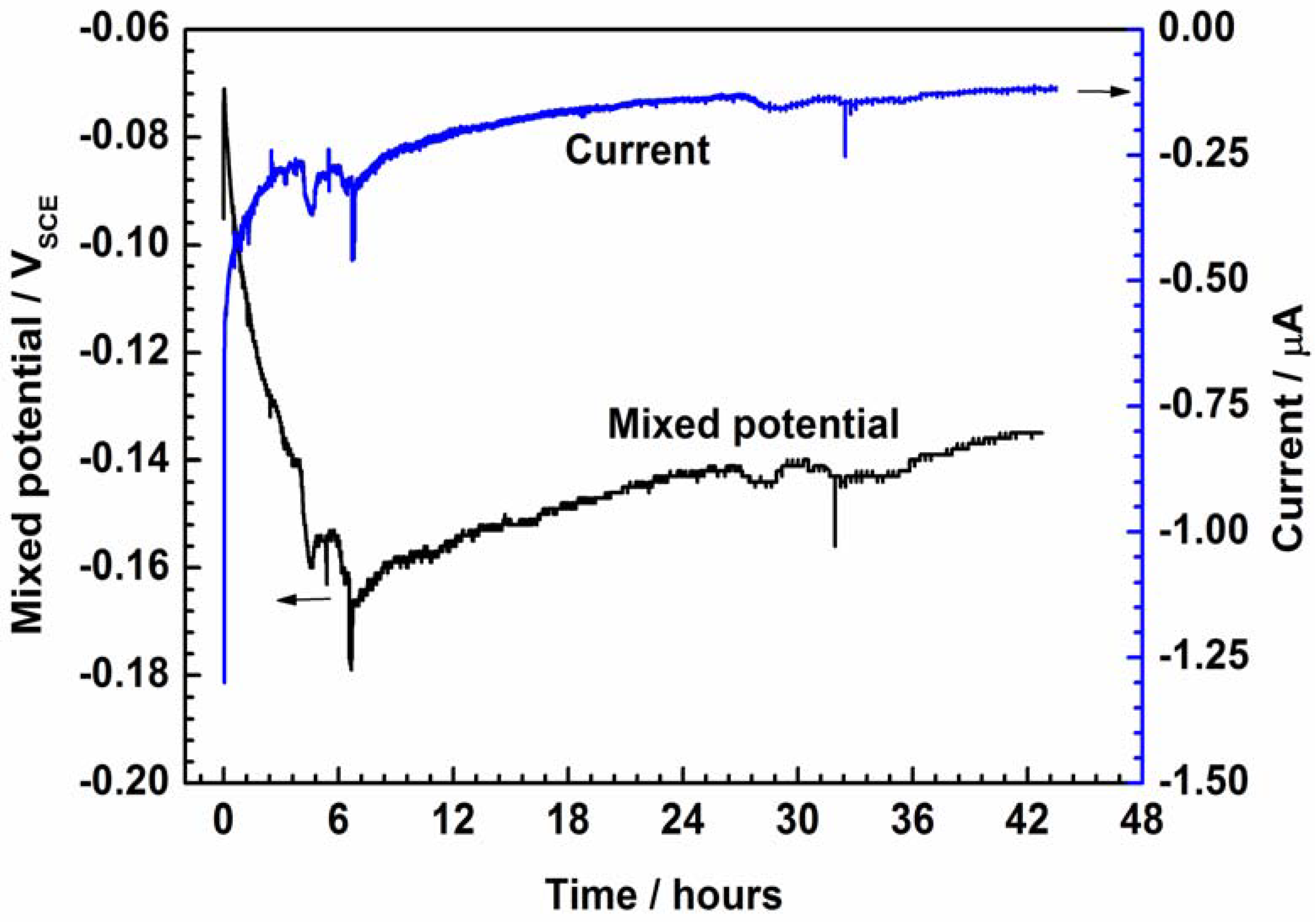

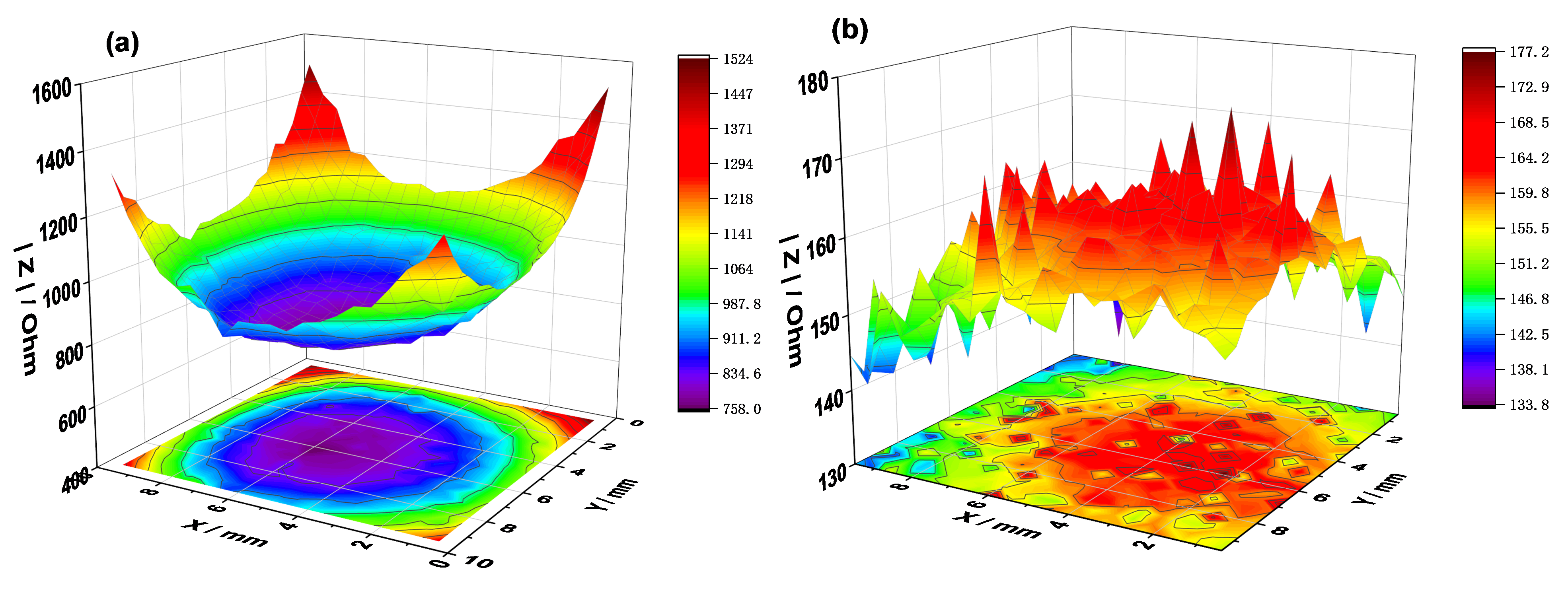

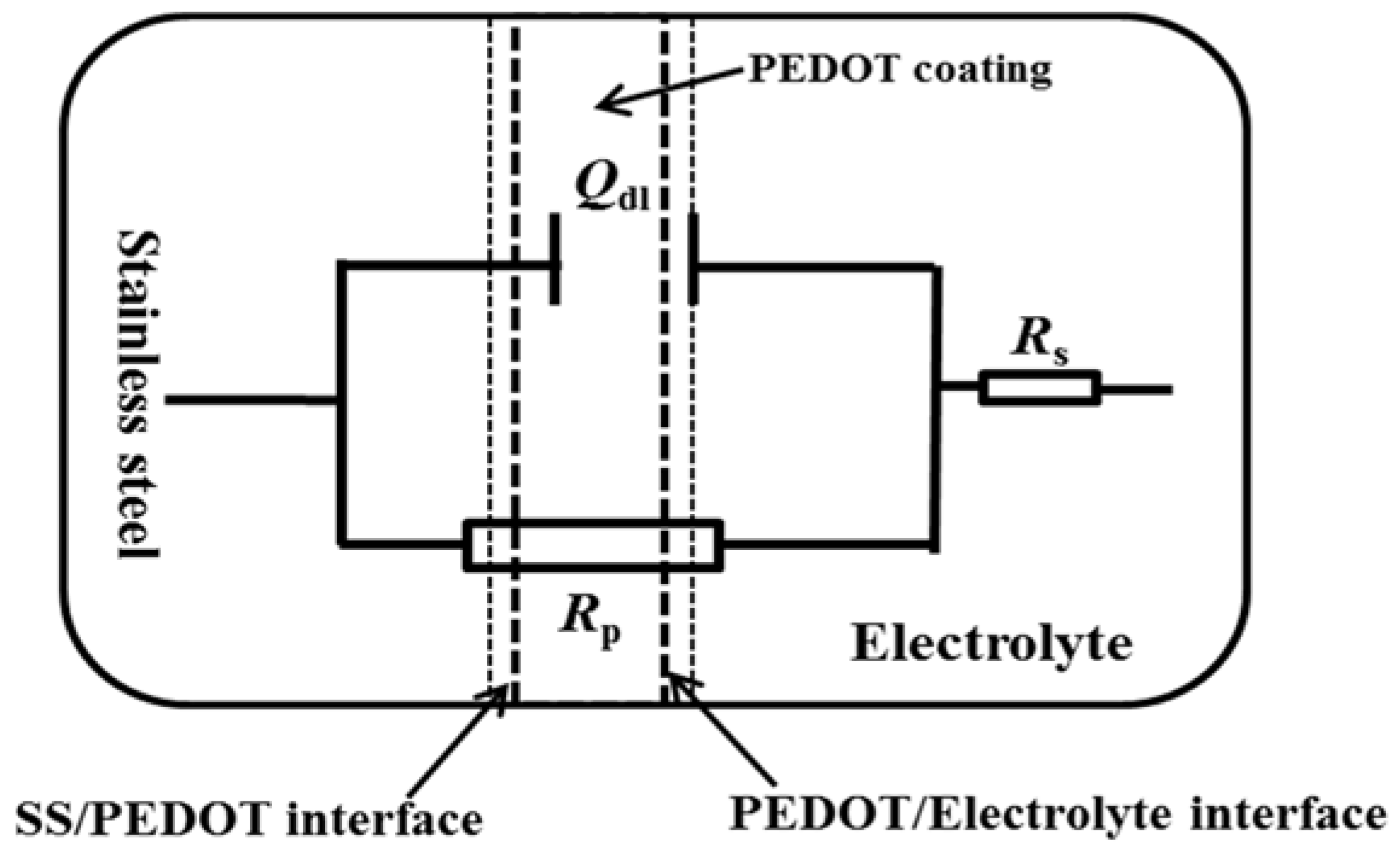
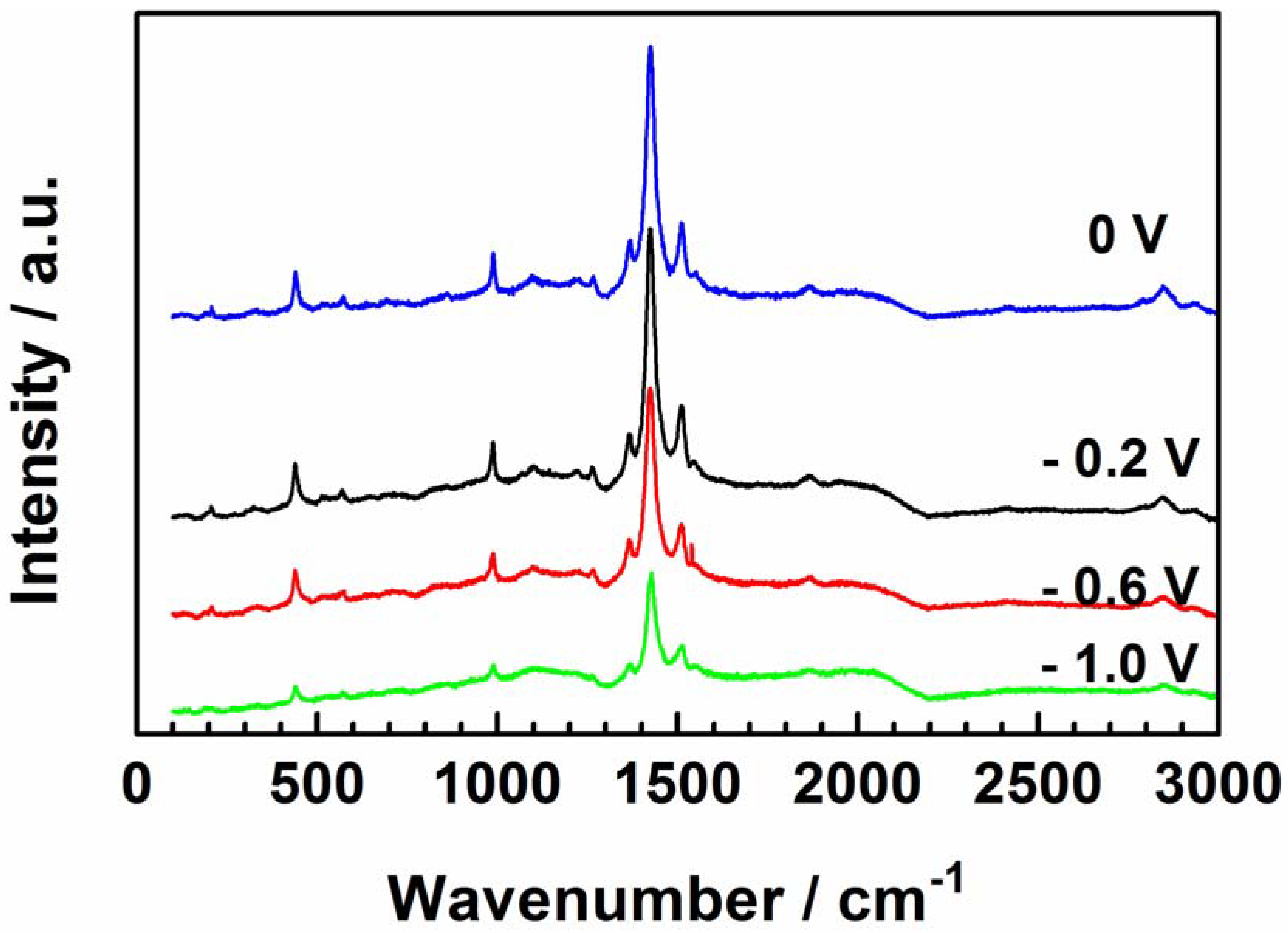
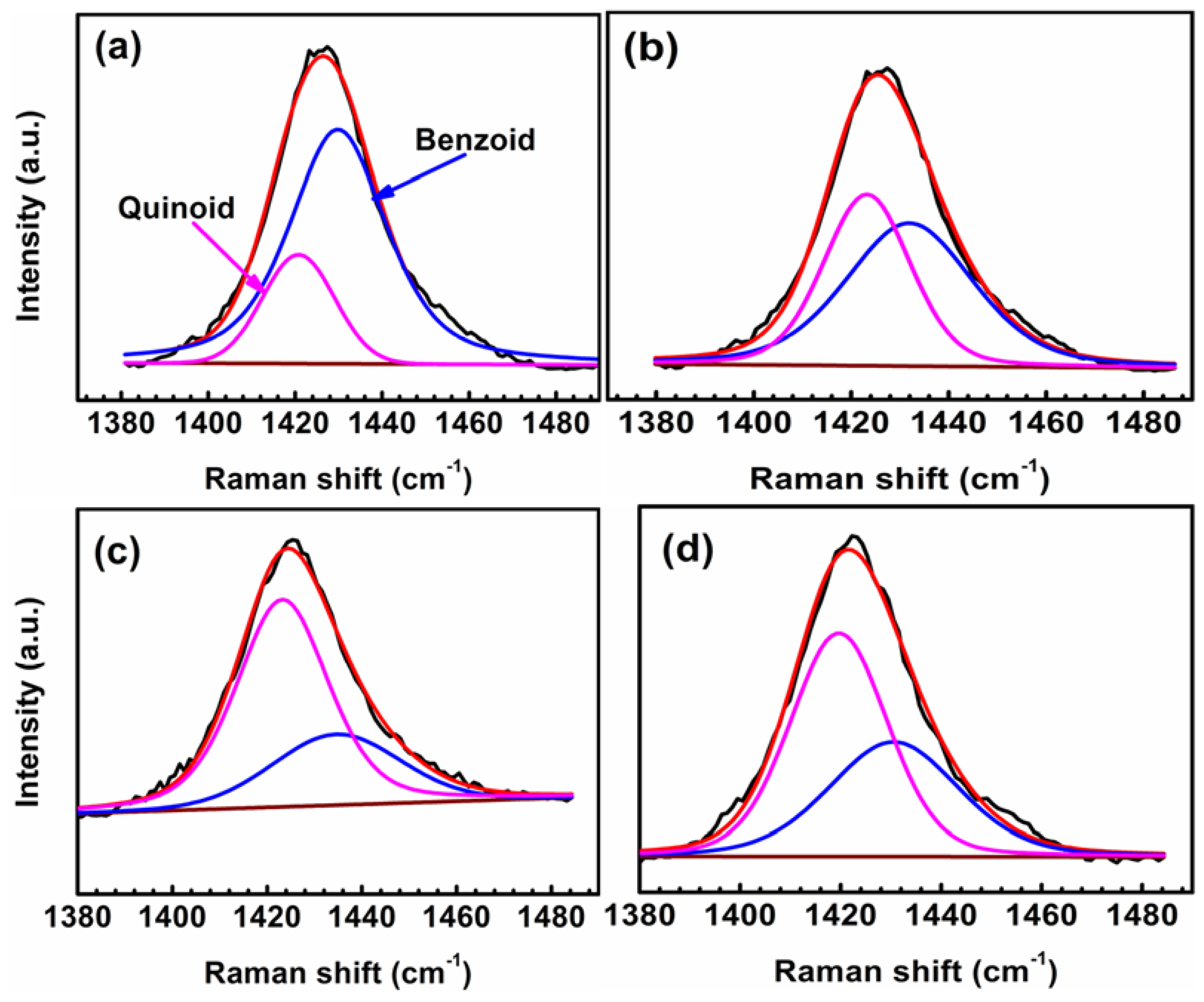
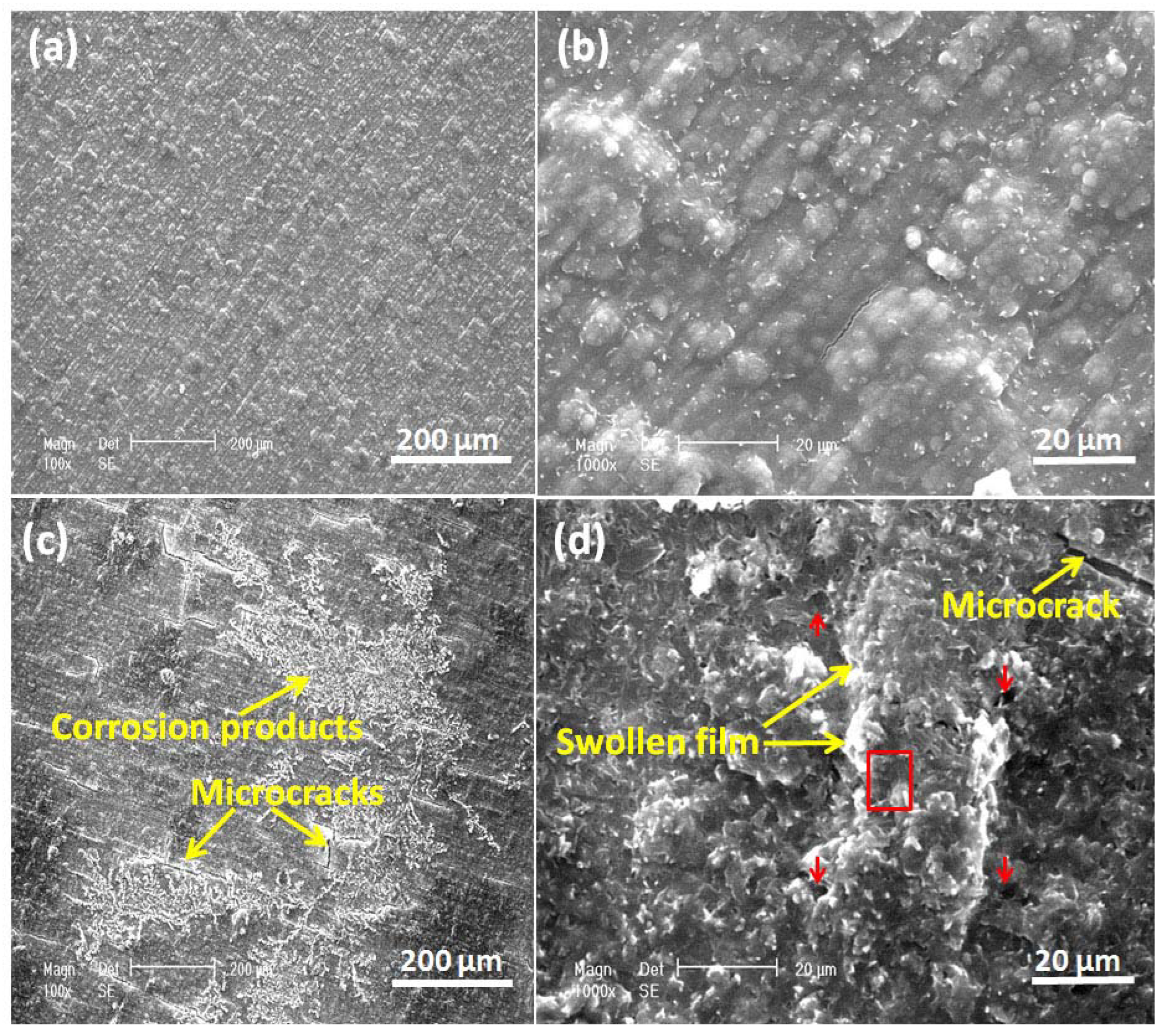
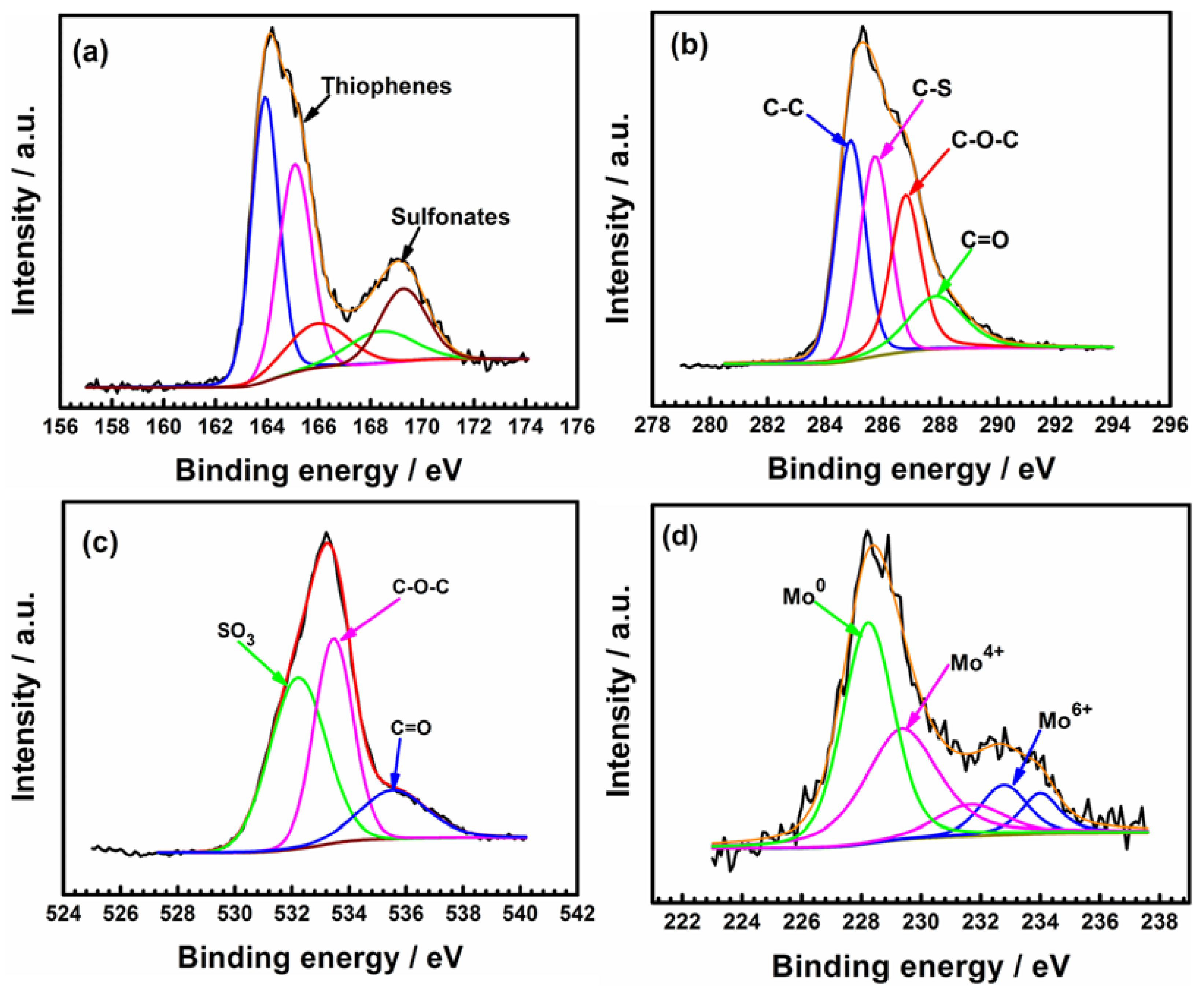

| Element | C | Mn | P | S | Cr | Ni | Mo | Si | N | Fe |
|---|---|---|---|---|---|---|---|---|---|---|
| Weight (%) | 0.03 | 1.62 | 0.04 | 0.01 | 18.1 | 11.9 | 2.40 | 0.28 | 0.10 | Bal. |
| Time/ Hours | Rs Ω·cm2 | Qdl Y0 Ssncm−2 | n | Rct KΩ·cm2 |
|---|---|---|---|---|
| 2 | 3.139 | 9.974 × 10−5 | 0.8394 | 14.63 |
| 6 | 5.374 | 7.661 × 10−5 | 0.8312 | 22.29 |
| 12 | 5.425 | 7.177 × 10−5 | 0.8330 | 26.09 |
| 24 | 5.334 | 7.738 × 10−5 | 0.8283 | 28.34 |
| 48 | 5.383 | 7.577 × 10−5 | 0.8402 | 19.35 |
| Polarized Potential VSCE | Rs Ω·cm2 | Qdl Y0 Ssncm−2 | n | Rct KΩ·cm2 |
|---|---|---|---|---|
| OCP | 6.618 | 4.045 × 10−5 | 0.9098 | 22.92 |
| −0.200 | 7.413 | 3.847 × 10−5 | 0.9071 | 56.63 |
| −0.300 | 7.380 | 4.308 × 10−5 | 0.9010 | 50.66 |
| −0.400 | 7.354 | 5.071 × 10−5 | 0.8929 | 25.81 |
| −0.600 | 7.212 | 8.780 × 10−5 | 0.8757 | 4.836 |
| −0.700 | 6.947 | 7.194 × 10−5 | 0.8742 | 2.393 |
| −0.800 | 7.152 | 4.775 × 10−4 | 0.8224 | 4.018 |
| −1.000 | 8.844 | 2.756 × 10−4 | 0.8438 | 7.728 |
| Polarization Potential | 0 V | –0.2 V | –0.6 V | –1.0 V |
|---|---|---|---|---|
| Percentage | 77% | 46% | 34% | 40% |
Disclaimer/Publisher’s Note: The statements, opinions and data contained in all publications are solely those of the individual author(s) and contributor(s) and not of MDPI and/or the editor(s). MDPI and/or the editor(s) disclaim responsibility for any injury to people or property resulting from any ideas, methods, instructions or products referred to in the content. |
© 2023 by the authors. Licensee MDPI, Basel, Switzerland. This article is an open access article distributed under the terms and conditions of the Creative Commons Attribution (CC BY) license (https://creativecommons.org/licenses/by/4.0/).
Share and Cite
Udowo, V.M.; Yan, M.; Liu, F.; Han, E.-H. Effect of Redox Switch, Coupling, and Continuous Polarization on the Anti-Corrosion Properties of PEDOT Film in NaCl Solution. Coatings 2023, 13, 944. https://doi.org/10.3390/coatings13050944
Udowo VM, Yan M, Liu F, Han E-H. Effect of Redox Switch, Coupling, and Continuous Polarization on the Anti-Corrosion Properties of PEDOT Film in NaCl Solution. Coatings. 2023; 13(5):944. https://doi.org/10.3390/coatings13050944
Chicago/Turabian StyleUdowo, Victor Malachy, Maocheng Yan, Fuchun Liu, and En-Hou Han. 2023. "Effect of Redox Switch, Coupling, and Continuous Polarization on the Anti-Corrosion Properties of PEDOT Film in NaCl Solution" Coatings 13, no. 5: 944. https://doi.org/10.3390/coatings13050944
APA StyleUdowo, V. M., Yan, M., Liu, F., & Han, E.-H. (2023). Effect of Redox Switch, Coupling, and Continuous Polarization on the Anti-Corrosion Properties of PEDOT Film in NaCl Solution. Coatings, 13(5), 944. https://doi.org/10.3390/coatings13050944





